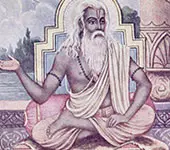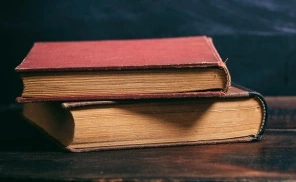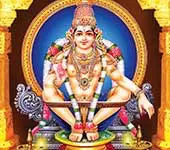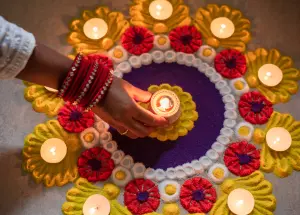Hinduism - 365 days of celebration

Hinduism epitomizes a spirit of gratitude and celebration spread across 365 days of the year. These festivals, deeply embedded in the rich tapestry of our culture, offer a diverse array of experiences, ranging from intimate home rituals to vibrant community gatherings. Rooted in tradition yet ever-evolving, they captivate hearts with their blend of solemnity and exuberance, inviting people of all ages to partake in prayers, delicacies, and joyful festivities.
The Seasonal Rhythm of Celebrations
Aligned with the cycles of nature and guided by the lunar calendar, Hindu festivals unfold with the changing seasons, infusing each month with its unique charm. The journey begins in January with Makara Sankranti, a homage to theSun god heralding the onset of a new year. February witnesses the solemn night of Shivaratri, dedicated to Lord Shiva, while spring ushers in the vibrant festivities of Rama Navami, celebrating the divine life of Lord Rama over nine auspicious days. As the warmth of summer envelops the land, August heralds the joyous Krishna Janmashtami, commemorating the birth of Lord Krishna, followed by the revered Ganesha Chaturthi in September, honoring the beloved elephant-headed deity.
With the advent of fall, we pay homage to the divine feminine through elaborate festivals dedicated to goddesses Lakshmi, Saraswati, and Durga. These celebrations, marked by grand processions, melodious performances, and sumptuous feasts, embody the spirit of reverence and revelry intertwined. Yet, it is perhaps the luminous spectacle of Diwali, the festival of lights, that casts its brilliance across the entirety of India and beyond, symbolizing the triumph of light over darkness, good over evil.
The daily celebration
The daily puja, a cherished ritual in every Hindu household, is affectionately termed 'Nityotsava', translating to the eternal celebration of divinity within our daily existence. This sacred practice serves as a profound reminder of the omnipresence of the divine in our lives, infusing each moment with reverence, gratitude, and spiritual connection. Through 'Nityotsava', families cultivate a deep sense of devotion and harmony, embracing the sanctity of everyday rituals as a sacred communion with the divine presence dwelling within and around them.
Regional Riches: Festivals of Diverse Flavors
Beyond the overarching calendar of national festivals, Hindu culture boasts a kaleidoscope of regional celebrations, each weaving its unique narrative of folklore, flora, and fauna. From the riotous colors of Holi in the north to the resplendent harvest festivals of Pongal in the south, these regional festivities pay homage to local legends and traditions, uniting communities in shared joy and camaraderie.
Embracing the Tapestry of Hindu Festivals
In the vibrant mosaic of Hindu festivals, diversity thrives as a testament to the cultural richness and spiritual fervor of a timeless tradition. Whether celebrated in the quiet sanctum of home or amidst the bustling streets of a community, each festival offers a moment of reflection, gratitude, and connection with the divine and with one another. As we traverse the cyclical journey of seasons and celebrations, let us revel in the kaleidoscope of colors, flavors, and traditions that adorn the canvas of Hindu festivity, embodying the eternal spirit of thanksgiving and joy.
Comments
Read more comments
Why is Bhishma great?
Bhishma is the perfect man of Mahabharata. By birth, he is a king, but on a trivial demand by a woman who his father was going to marry gave up his kingdom and married life. Still, he continued to protect the kingdom as its pillar of strength. He was afraid of none. His sense of duty is incomparable which he performed with detachment. Even when Duryodhana ignored his advice, he fought as his commander and wreaked havoc upon the Pandava army. In the end, he chose to die and adopted Yoga bhava.
What is Abhayam?
Earth is made up of seven continents. One among them is Plakshadvipa. Idhmajihva was a king of Plakshadvipa. He divided it into 7 parts. Abhayam is one among them. The others are - Shivam, Yamasam, Subhadram, Shantam, Kshemam, and Amritam. It was conquered by Bhimasena during Digvijaya yatra before the Rajasuya yaga of the Pandavas.
Quiz
What are the energy centers in the path of Kundalini called?Recommended for you
How to manage tendency to become greedy
 Click here to know more..
Click here to know more..
Fasting - Its Science And Art

Meaning of fasting, Fasting is not starving, Chemical and organic changes during fasting, Repair of organs and tissues, Can fasting cure diseases?....
Click here to know more..Shabari Gireesha Ashtakam

shabarigiripate bhootanaatha te jayatu mangalam manjulam mahah'. mama hri'disthitam dhvaantaram tava naashayadvidam skandasodara. kaantagiripate kaami....
Click here to know more..
English Topics
Festivals
Click on any topic to open
- 5 Hinduism - 365 days of celebration
- 4 Angarki Chaturthi - Significance, Legend, and Dates
- 3 Why Is Bhai Dooj Celebrated
- 2 Vasantha Panchami
- 1 Rama Navami
Please wait while the audio list loads..
30
Ganapathy
Shiva
Hanuman
Devi
Vishnu Sahasranama
Mahabharatam
Practical Wisdom
Yoga Vasishta
Vedas
Rituals
Rare Topics
Devi Mahatmyam
Glory of Venkatesha
Shani Mahatmya
Story of Sri Yantra
Rudram Explained
Atharva Sheersha
Sri Suktam
Kathopanishad
Ramayana
Mystique
Mantra Shastra
Bharat Matha
Bhagavatam
Astrology
Temples
Spiritual books
Purana Stories
Festivals
Sages and Saints
